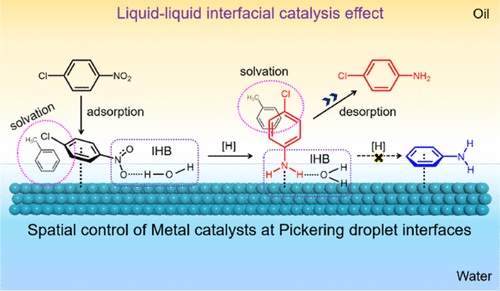
探索调整催化选择性的新方法是催化界长期追求的目标。
该文中,Pickering乳液的油水界面被开发用于有效地调节氢化反应的催化选择性,这是通过精确控制金属纳米颗粒在液滴界面的空间分布实现的。研究发现,与纯水(68.5%)或纯有机溶剂(46.8%)中的外界面层(63.6%)相比,位于Pickering液滴内界面层的钯纳米颗粒显著增强对氯硝基苯氢化中对对氯苯胺的选择性(高达99.6%),如此显著的界面微区依赖性催化选择性归因于水和有机溶剂在液滴界面共存的微环境,这可以提供独特的界面氢键相互作用和溶剂化效应,从而改变对氯硝基苯和对氯苯胺在Pd纳米颗粒上的吸附模式,从而避免C–Cl键与金属表面的不必要接触。研究人员在液-液界面对催化剂进行精确空间控制的策略和该文报道的前所未有的界面效应不仅为液-液的界面反应提供了新的见解,而且为提高催化选择性开辟了一条途径。
附:英文原文
Title: Boosting Catalytic Selectivity through a Precise Spatial Control of Catalysts at Pickering Droplet Interfaces
Author: Houbing Zou, Hu Shi, Shijiao Hao, Yajuan Hao, Jie Yang, Xinxin Tian, Hengquan Yang
Issue&Volume: January 18, 2023
Abstract: Exploration of new methodologies to tune catalytic selectivity is a long-sought goal in catalytic community. In this work, oil–water interfaces of Pickering emulsions are developed to effectively regulate catalytic selectivity of hydrogenation reactions, which was achieved via a precise control of the spatial distribution of metal nanoparticles at the droplet interfaces. It was found that Pd nanoparticles located in the inner interfacial layer of Pickering droplets exhibited a significantly enhanced selectivity for p-chloroaniline (up to 99.6%) in the hydrogenation of p-chloronitrobenzene in comparison to those in the outer interfacial layer (63.6%) in pure water (68.5%) or in pure organic solvents (46.8%). Experimental and theoretical investigations indicated that such a remarkable interfacial microregion-dependent catalytic selectivity was attributed to the microenvironments of the coexistence of water and organic solvent at the droplet interfaces, which could provide unique interfacial hydrogen-bonding interactions and solvation effects so as to alter the adsorption patterns of p-chloronitrobenzene and p-chloroaniline on the Pd nanoparticles, thereby avoiding the unwanted contact of C–Cl bonds with the metal surfaces. Our strategy of precise spatial control of catalysts at liquid–liquid interfaces and the unprecedented interfacial effect reported here not only provide new insights into the liquid–liquid interfacial reactions but also open an avenue to boost catalytic selectivity.
DOI: 10.1021/jacs.2c12120
Source: https://pubs.acs.org/doi/10.1021/jacs.2c12120
JACS:《美国化学会志》,创刊于1879年。隶属于美国化学会,最新IF:16.383
官方网址:https://pubs.acs.org/journal/jacsat
投稿链接:https://acsparagonplus.acs.org/psweb/loginForm?code=1000
